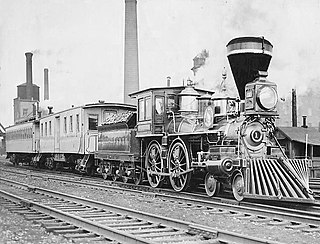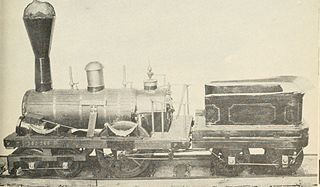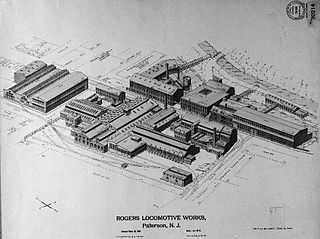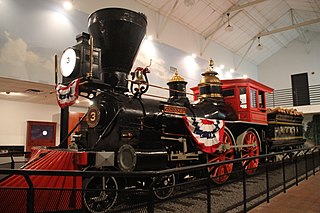
The American Locomotive Company was an American manufacturer that operated from 1901 to 1969, initially specializing in the production of locomotives but later diversifying and fabricating at various times diesel generators, automobiles, steel, tanks, munitions, oil-production equipment, as well as heat exchangers for nuclear power plants.

The New York, Susquehanna and Western Railway, also referred to as the Susie-Q or the Susquehanna, and formerly referred to as the New York, Susquehanna and Western Railroad, is an American Class II freight railway that operates over 400 miles (640 km) of trackage in the states of New Jersey, New York, and Pennsylvania.

The William Crooks is a 4-4-0 steam locomotive that was the first locomotive to operate in the State of Minnesota, beginning in 1861. It was named after William Crooks, the Chief Mechanical Engineer for the St. Paul and Pacific Railroad. He served as a colonel and commander of the 6th Minnesota Volunteer Infantry Regiment during the American Civil War. Crooks laid the initial 10-mile (16 km) track between Minneapolis and St. Paul, and the William Crooks was the first locomotive to run on the line.

Sandusky was the name of a steam railroad locomotive, a 4-2-0, built in the United States. This locomotive included engineering features that hadn't been used before in locomotive construction and it played an integral role in the railroad history of Ohio.

The Cooke Locomotive and Machine Works, located in Paterson, New Jersey, manufactured steam railroad locomotives from 1852 until it was merged with seven other manufacturers to form American Locomotive Company (ALCO) in 1901.

4-4-0, in the Whyte notation, denotes a steam locomotive with a wheel arrangement of four leading wheels on two axles, four powered and coupled driving wheels on two axles, and no trailing wheels.

Rogers Locomotive and Machine Works was a manufacturer of railroad steam locomotives based in Paterson, in Passaic County, New Jersey, in the United States. Between its founding in 1832 and its acquisition in 1905, the company built more than 6,000 steam locomotives for railroads around the world. Most 19th-century U.S. railroads owned at least one Rogers-built locomotive. The company's most famous product was a locomotive named The General, built in December 1855, which was one of the principals of the Great Locomotive Chase of the American Civil War.

Matthew Baird was one of the early partners in the Baldwin Locomotive Works.

Western & Atlantic Railroad #3 General is a 4-4-0 "American" type steam locomotive built in 1855 by the Rogers, Ketchum & Grosvenor in Paterson, New Jersey for the Western & Atlantic Railroad, best known as the engine stolen by Union spies in the Great Locomotive Chase, an attempt to cripple the Confederate rail network during the American Civil War. Today, the locomotive is preserved at the Southern Museum of Civil War and Locomotive History in Kennesaw, Georgia, and is listed on the National Register of Historic Places.
William Swinburne (1805–1883) was an American businessman and locomotive builder who pioneered steam locomotive building in the United States. He was a founder of Swinburne, Smith and Company.
Robert S. Hughes was the third president of Rogers Locomotive and Machine Works. Before becoming president when Jacob S. Rogers resigned in 1893, he served as the company's treasurer. When Hughes took the reins at Rogers he led the company through a reorganization to emerge as Rogers Locomotive Company; Hughes remained the company president until his death in 1900.

The NZR K class of 1877 was the first example of American-built locomotives to be used on New Zealand's rail network. Their success coloured locomotive development in New Zealand until the end of steam.
The National Railway Historical Society (NRHS) is a non-profit organization established in 1935 in the United States to promote interest in, and appreciation for the historical development of railroads. It is headquartered in Philadelphia, Pennsylvania, and organized into 16 regions and 170 local chapters located in the United States, Canada, and the United Kingdom. The NRHS sponsors the popular RailCamp summer orientation program in partnership with Amtrak and the National Park Service, offering high school youth hands-on experience in the railroad industry.

Louisville & Nashville 152 is a preserved K-2a class 4-6-2 "Pacific" type steam locomotive listed on the National Register of Historic Places, currently homed at the Kentucky Railway Museum at New Haven, Kentucky in southernmost Nelson County, Kentucky. It is the oldest known remaining 4-6-2 "Pacific" type locomotive to exist. It is also the "Official State Locomotive of Kentucky", designated as such on March 6, 2000. The locomotive is currently owned and being restored back to operating condition by the Kentucky Railway Museum.

Grant Locomotive Works was an American manufacturer of steam railway locomotives from 1867 to 1895, first in Paterson, New Jersey, and then in Chicago. The company built about 1,888 locomotives.

The Northern Pacific class S-10 was a type of steam locomotive in use on American railroads in the early 20th century. The first engines of the type were introduced in 1905, and ten were acquired by the Northern Pacific Railway (NP) in 1907, continuing in service until the 1930s and 1940s. One of the engines, Specifically No. 328, has been preserved.

Under the Whyte notation for the classification of steam locomotives, 4-2-2-0 represents the wheel arrangement of four leading wheels on two axles, four independently driven driving wheels on two axles, and no trailing wheels. The arrangement became known as double single.

Paul Rapsey Hodge was an English-American inventor and mechanical engineer. He invented technological improvements used by railroad companies. He also invented a device that ground wheat and other grains into flour that could then be used by bakers, as well as a machine that turned vegetable pulp into paper that could be used by printers. His innovations were useful to many industries. He was a writer of technical manuals in both the United States and England.

William Buchanan was an American mechanical engineer. He spent most of his career designing high-speed steam locomotives for the New York Central Railroad including the New York Central and Hudson River Railroad No. 999 locomotive, designed to travel over 100 miles per hour (160 km/h). He also designed and improved freight locomotives for hauling heavy commercial freight. He was an authority on mechanical engineering in America and Europe and was elected to membership of the Institute of Civil Engineers of London.
















